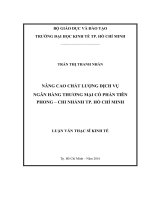Luận văn thạc sĩ nâng cao chất lượng dịch vụ bidv ibank tại BIDV chi nhánh sở giao dịch 1
Bạn đang xem bản rút gọn của tài liệu. Xem và tải ngay bản đầy đủ của tài liệu tại đây (1.32 MB, 107 trang )
ĐẠI HỌC QUỐC GIA HÀ NỘI
KHOA QUẢN TRỊ VÀ KINH DOANH
---------------------
NGUYỄN THẾ ANH
IMPROVING SERVICE QUALITY OF BIDV IBANK
AT BIDV SO GIAO DICH 1 BRANCH
NÂNG CAO CHẤT LƯỢNG DỊCH VỤ
BIDV IBANK TẠI BIDV CHI NHÁNH SỞ
GIAO DỊCH 1
LUẬN VĂN THẠC SĨ QUẢN TRỊ KINH DOANH
HÀ NỘI - 2020
ĐẠI HỌC QUỐC GIA HÀ NỘI
KHOA QUẢN TRỊ VÀ KINH DOANH
---------------------
NGUYỄN THẾ ANH
IMPROVING SERVICE QUALITY OF BIDV IBANK
AT BIDV SO GIAO DICH 1 BRANCH
NÂNG CAO CHẤT LƯỢNG DỊCH VỤ
BIDV IBANK TẠI BIDV CHI NHÁNH SỞ
GIAO DỊCH 1
Chuyên ngành: Quản trị kinh doanh
Mã số: 8340101.01
LUẬN VĂN THẠC SĨ QUẢN TRỊ KINH DOANH
NGƯỜI HƯỚNG DẪN KHOA HỌC: TS. TRẦN KIM HÀO
HÀ NỘI - 2020
DECLARATION
The author confirms that the research outcome in the thesis is the result of
author‟s independent work during study and research period and it is not yet
published in other‟s research and article.
The other‟s research result and documentation (extraction, table, figure,
formula, and other document) used in the thesis are cited properly and the
permission (if required) is given.
The author is responsible in front of the Thesis Assessment Committee,
Hanoi School of Business and Management, and the laws for above-mentioned
declaration.
i
ACKNOWLEDGEMENT
After studying MBA course, I have attained plenty of various knowledge,
skills and insights. The course raises my capacity of administration and
management up to the next level.
I declare that this is a true copy of my thesis. The content of this thesis has
been approved by the committee of Vietnam National University, Hanoi – Hanoi
School of Business and Management (HSB). This thesis has not been submitted for
a higher degree to any other University or Institution.
I would like to thank sincerely people for heloping, supporting and guiding
me conscientiously in order to finish this thesis successfully.
First of all, I would like to thank all the professors of MBA program,
especially Dr. Tran Kim Hao – my supervisor. Then I would like to thank deeply to
the directors and staff of BIDV So Giao Dich 1 Branch, respondents and
interviewees who allowed me to gather enough data for this research. Finally, I
would like to express my thanks to my wife, my family, my colleges and my fellow
friends who always stand by me during the past two years and encourage me to
keep moving from the beginning of my study.
ii
TABLE OF CONTENT
DECLARATION........................................................................................................ i
ACKNOWLEDGEMENT........................................................................................ ii
LIST OF TABLES..................................................................................................... v
LIST OF FIGURES.................................................................................................. vi
INTRODUCTION..................................................................................................... 1
CHAPTER 1: THEORETICAL BACKGROUND ON SERVICE QUALITY AND
INTERNET BANKING............................................................................................ 8
1.1. Internet banking.................................................................................................. 8
1.1.1. Electronic banking........................................................................................... 8
1.1.2. Internet banking............................................................................................... 8
1.2. Services............................................................................................................ 10
1.3. Service quality.................................................................................................. 10
1.4. Internet Banking service quality....................................................................... 12
1.5. Service quality assessment models................................................................... 17
1.5.1 Servqual model............................................................................................... 17
1.5.2. Servperf model.............................................................................................. 20
1.6. Proposed model and hypothesis of the research............................................... 21
1.6.1. Propsosed conceptual model......................................................................... 21
1.6.2 Proposed hypothesis of the research............................................................... 22
CHAPTER 2: ASSESSING THE SITUATION
OF BIDV IBANK SERVICE
QUALITY AT THE BANK FOR INVESTMENT AND DEVELOPMENT OF
VIETNAM – SO GIAO DICH 1 BRANCH........................................................... 24
2.1. Introduction of BIDV – SO GIAO DICH 1 BRANCH and BIDV iBankservice
................................................................................................................................ 24
2.1.1. Foundation and development history............................................................. 24
2.1.2. Introduction about BIDV So giao dich 1 Branch........................................... 28
2.1.3. BIDV IBank.................................................................................................. 31
2.2. General assessment of the quality of IBank service BIDV So Giao Dich 1
Branch..................................................................................................................... 41
iii
2.2.1 Advantages:.................................................................................................... 42
2.2.2 Limitations..................................................................................................... 43
2.3 Reasearch finding result.................................................................................... 45
2.3.1 Internal data finding result.............................................................................. 45
2.3.2 Survey results on quality of iBank service at Bank for Development and
Investment of Vietnam, So Giao Dich 1 branch...................................................... 47
2.4 Research result discussion................................................................................. 57
CHAPTER 3: SOLUTIONS TO IMPROVE SERVICE QUALITY OF BIDV
IBANK AT BIDV SO GIAO DICH 1 BRANCH.................................................... 59
3.1 Orientation on the development of BIDV iBank............................................... 59
3.2 Research recommendations............................................................................... 59
3.2.1. Recommendations for BIDV So Giao Dich 1 Branch:..................................59
3.2.2. Suggestions to the Government:.................................................................... 62
CONCLUSIONS, LIMITATIONS AND IMPLICATIONS....................................64
1. Conclusions......................................................................................................... 64
2. Limitations.......................................................................................................... 66
2.1. Limitation of Sampling.................................................................................... 66
2.2. Limitation of the option format of the answers................................................ 66
3. Implications......................................................................................................... 66
REFERENCES........................................................................................................ 67
APPENDIX I........................................................................................................... 74
iv
LIST OF TABLES
Table 1.1. Key determinants of internet banking service quality............................. 15
Table 2.1: Business results of the Branch in the stage of 2017 -2019......................30
Table 2.2. BIDV iBank Fee Schedule...................................................................... 37
Table 2.3: Factors table after Cronbach test............................................................ 52
Table 2.4: Reliable observed variables after running exploratory factor analysis....54
Table 2.5. Correlation analysis................................................................................ 55
v
LIST OF FIGURES
Figure 1.1. Five key elements as central influences on perceived quality...............13
Figure 1.2. Service Quality 5 Gap Model in SERVQUAL......................................20
Figure 1.4: Conceptual model of the research......................................................... 22
Figure 2.1. Registered customer number by year.................................................... 45
Figure 2.2. Proportion of customer by service package........................................... 45
Figure 2.3 Proportion of customer and proportion of transaction volume by type of
corporation.............................................................................................................. 46
Figure 2.4. Number of registered customer by service function..............................46
Figure 2.5. Gender and age statistic........................................................................ 47
Figure 2.6. Company size and industry statistic...................................................... 48
Figure 2.7. Service package statistic....................................................................... 48
Figure 2.8. Main reason to use iBank service statistic............................................. 49
Figure 2.9. Customer problem while using service statistic....................................49
Figure 2.10. Transaction frequency statistic............................................................ 50
Figure 2.11. Amount of transactions per month statistic.........................................50
Figure 2.12. Transaction volumes per month.......................................................... 51
Figure 2.13. Calibration model of service quality................................................... 56
vi
INTRODUCTION
1. Rationale of the study
Under the development of market economy, the competition between
financial institutions is stronger and the requirements of customers are higher day
by day, especially in the storm of technology development, internet banking was
born and continuously developed and improved. Information technology is a key to
achieve competitive advantages and has been developing rapidly in recent years. In
order to provide customers efficient banking services, information technology and
the internet become more and more important for banks to delivery banking
services. Banks have begun to setup their own web portal to provide internet service
and gain the advantages of unlimited time, area, fewer cost, and more customers
from internet banking.
The service quality plays an important role for banks to compete. Therefore,
it is important to utilize good service quality in order to differentiate itself from
other service providers. Although the form of internet services is different from that
of traditional services, service quality is still the core competitiveness of internet
banking. In view of development, service quality is a crucial issue in internet
banking. Service quality is one of most heavily researched constructs in the field of
service marketing.
In Vietnam, the situation in recent years showing the tendency of using
electronic services over internet is becoming prevalent, the conveniences brought
about by internet banking are great. For the banks, the initial investments of
technology can be expensive but the benefits on human resource' investment are not
small. Internet banking help banks reduce the cost for staffs, offices, printings,
storage. For customers, they will be satisfied by the speed of services, saving the
cost and time, reducing paper procedures from the bank.
In this tendency toward customers, BIDV in general and BIDV So Giao Dich
1 branch in particular is one of pioneers in developing electronic banking services
as Internet Banking, Home Banking; Phone Banking; Mobile Banking...and
1
recently as BIDV iBank. With the modern technicalbanking infrastructure, BIDV is
holding many opportunities to the application of advanced technology in automatic
operations and offering BIDV iBank to customers.
BIDV So Giao Dich 1Branch is a major and leading branch of BIDV. Being
aware of the importance of service quality to satisfy customer and get their loyalty,
BIDV So Giao Dich 1 Branch has been applying modern technology in improve
performance of Internet Banking service. Up to now, BIDV IBank has been
attracting more and more customers by the benefits of the service. The number of
customers registered this service has been increasing over the year. However, the
satisfaction of customers toward BIDV IBank service quality in So Giao Dich 1
branch seems to be not high, the rate of customer registering BIDV iBank financial
packages is still low. This put urgent need for the author for assessing the situation
to give out measures aiming to improve service quality to enhance customer
satisfaction, attract more customers, push up the rate of BIDV iBank usage, raise the
trust of customer toward BIDV So Giao Dich 1 Branch service.
With above reasons, the author decides to choose the topic "Improving
service quality of BIDV iBank at BIDV So giao dich 1Branch" for mater thesis.
2. Literature review
2.1. Research on the world
Jun et.al. (2001) in research on " The key determinants of internet banking
service quality: a content analysis " focus on the issues associated with internet
banking service quality. Identified a total of 17 dimensions of internet banking
service quality which can be classified into three broad categories: customer service
quality, banking service quality and online systems quality. The most frequently
dimensions as the main sources of satisfaction of dissatisfaction were reliabity,
responsiveness, access and accuracy. The findings help the author the guidance for
the study.
Khan et. al. (2009) in the study aims at evaluating the service quality of
internet banking (i-banking) services in India from customer's perspective. A
structured questionnaire containing 44 quality items is administered to various
2
target groups. Seven quality dimensions, viz. reliability, accessibility, userfriendliness, privacy/security, efficiency, responsiveness and fulfilment, are
identified based on principal component factor analysis. Demographic analysis of
data reveals that gender is hardly a bias for use and evaluation of service quality of
i-banking in most of the cases across various categories of customers. A valid
mathematical model is proposed to assess the overall service quality using
regression analysis. The results show that customers are satisfied with quality of
service on four dimensions such as reliability, accessibility, privacy/security,
responsiveness and fulfilment, but least satisfied with the 'user-friendliness'
dimension. The empirical findings not only prioritise different parameters but also
provide guidelines to bankers to focus on the parameters on which they need to
improve.
Simon et. al. (2013) in their empirically research on “Customer Satisfaction
with Internet Banking Service Quality in The Ghanaian Banking Industry collected
the main data from 200 respondents of the two banks. The results show that
customers of Merchant Bank, Ghana are satisfied with the quality of IB services
offered by Ghana Commercial Bank. In addition, the income factor also affects
customer satisfaction towards IB service quality. In general, the customers of the
two banks are unhappy with the speed of the transaction, feedback to customers,
online leads, offers, fees for IB services. The findings of the study are both
theoretical and practical, contributing to the research literature on service quality of
internet banking.
2.2. Research in Vietnam
Tran Thi Thu Duyen (2012) in her thesis on the contents "Improving the
quality of IB services of Dong A Commercial Joint Stock Bank" showed the
contents of IB and service quality. After analyzing two service quality measurement
models, SERVQUAL and SERVPERF, the researcher developed a model for the
SERVQUAL model to conduct a review of the IB service quality of Dong A
Commercial Joint Stock Bank through quantitative analysis and proposed some
3
solutions and recommendations. That helps the author have a lot of findings to
apply to research the objects at BIDV SGD1.
Truong Huyen Uyen Trang (2013) in her thesis on the topic "Improving the
quality of IB services at Vietnam Maritime Commercial Joint Stock Bank, Thua
Thien Hue Branch" also uses 02 models SERVQUAL and SERVPERF, the
reseacher has conducted surveys with model 150 Votes (135 valid votes). T-test and
quantitative analysis using SPSS are tools that help the author analyze collected data
to produce results and recommendations.
Nguyen Lam Hoang Yen (2013) in the thesis on "Measuring IB service
quality of Asia Commercial Bank, Da Nang branch" also presented some basic
issues of service, service quality and models of customer satisfaction index; The
author Yen has chosen the model SERVPERF as a model of research for
dissertation. The researcher also used quantitative research with the model
SERVPERF research to analyze the quality of IB services of Asia Commercial Bank
at Da Nang branch in the study of the situation. The study aimed at measuring the
service quality in the reference of foreign banks with a lot of differences that help to
provide good experiences for the thesis of the author.
The other study by Nguyen Phuoc Quy Hoang (2013) in the Master's thesis
on "Improving the quality of IB services of the Bank for Investment and
Development of Vietnam, Thua Thien Hue Branch". The researcher also presented
basic concepts, research models, quantitative analysis and specific solutions. The
differences in the research object also makes the work as a good reference for the
author to learn.
3. Objectives of the study
3.1. Overall objective
Base on evaluating service quality of iBank at BIDV So Giao Dich 1 Branch,
the study will recommend the solutions to improve the quality of iBank at BIDV So
Giao Dich 1 Branch in particular and BIDV in genaral.
3.2. Specific objectives
4
Reviewing the service quality measurement models and building a suitable
model for measuring iBank service quality.
Analizing and evaluating the situation of iBank service quality at BIDV So
Giao Dich 1 Branch by selected model; Outcomes, shortcomings and causes
Recommending suitable solutions to improve iBank service quality at BIDV
So Giao Dich 1 Branch
4. Subject and scope of the study
4.1. Subject of the study
Subject of the study are iBank service atBIDV So Giao Dich 1 Branch
Survey subjects are individuals, organizations who have been using iBank
provided by BIDV So Giao Dich 1 Branch. Until 31
st
of May, 2020, there are
approximately 300 customers who have already been using IBank service of
financial packages. Therefore, research aim to survey one third of IBank customer
to discover factors affecting to IBank service quality.
4.2. Scope of the study
- Scope of content: Service quality and solutions to improve it
- Scope of space: BIDV So Giao Dich 1 Branch, Hanoi.
- Scope of time: Secondary data used in between 2019 and 2020
5.
Research methodology
5.1. Data collection method
- Secondary Data Collection
Secondary data will be collected through reports of the BIDV Planning &
Finance Department of BIDV So Giao Dich 1 Branch.
-
Primary data collection:
Primary data were collected from survey questionnaires to individuals,
organizations who have been using iBank provided by BIDV So Giao Dich 1 Branch in
June 2020. Expert interviews, observations and synthetic analytics will be applied
The research process is expressed in detail as following:
5
Base on reviewing theoretical literature and previous model, the author
proposes the most appropriate research model. The author will apply quantitative
research method which includes some following steps:
• Building the questionnaire based on the proposed theoretical model
• Determining the sample size
• Collecting responses
•
Cleaning data, putting into SPSS software, run the Ordinary
Least Squares regression (OLS) analysis.
Base on the regression analysis, the research results will be discussed in detail,
andthen severalsolutions will be recommended for improving the service quality of
iBank service
-
Sample size: 100 by random sampling
and
Sampling objects: BIDV SO GIAO DICH 1 BRANCH‟s individual
organizational customers who use iBank on average five times a month (that is to
ensure that chosen customers use IBank service frequently and understand it well)
Sample size can be identified by the formula ofCochran(1977):
- Selectp=q=0,5
2
-Z
α/2=
1,96;ε = 10%; with 1- α = 95%:
The minimum sample size is 96, but the author select sample size of 100 to
survey to minus the case customers have no answer. The results of survey are
treated by SPSS software and calculated by statistic tools.
5.2 Data analysis method
The research uses spss software to analyze questionnaire result through
cronbach alpa analysis, exploratory factor analysis, correlation analysis and
regression analysis
6
6. Thesis structure
In addition to the introduction, conclusion, references, appendixes; the
dissertation is divided into three chapters:
Chapter 1: Theoretical background on service quality and internet banking
Chapter 2: Assessing the situation of BIDV iBank service quality at the Bank for
Investment and Development of Vietnam – So giao dich 1 branch.
Chapter 3: Solutions to improve service quality of BIDV iBank at BIDV So giao
dich 1 branch.
7
CHAPTER 1: THEORETICAL BACKGROUND ON SERVICE QUALITY
AND INTERNET BANKING
1.1. Internet banking
1.1.1. Electronic banking
For electronic banking, products and services can be defined as the bank
distribution channel. There are various definitionsaboutelectronic banking according
to the given subject and researchers (Daniel 1999). Mobarek (2007) states that
electronic and interactive communication channels, both new and traditional,
transfer banking products and services directly to customers through an automatic
distribution and “is defined as electronic banking, a new distribution channel for
banking services by electronic banking (Mols 1998). Electronic banking definitions
vary amongst researchers partially because electronic banking refers to several types
of services through which bank customers can request information and carry out
most retail banking services through computer connected network, television or
mobile phone” (Mols 1998). In line with this, Kolodinsky et al (2004) mention that
electronic banking could also be defined in several different platforms as follows:
•
Internet banking or online banking
•
PC banking or offline banking
•
Telephone banking
•
Mobile phone banking
•
TV–based banking
1.1.2. Internet banking
Internet banking via the mobile phone is considered fast and reliable. Studies
states that Internet banking or online banking transactions is achieved with the
Internet connected to a network and is said to be a safe and useful way to conduct
banking. Electronic banking services can be done at home without the stress of
going to the bank to perform the same operations, such as office 3 account balances
or funds transfers, bill payments, money transfers and online shopping transactions.
Online banking services and products include account access, account statements,
8
fixed deposit inquiries, money transfers, credit card payments, invoices, payments
and checkbook requests. As more people embrace the Internet, online banking is
expected to grow. This expected growth will also affect people‟s income and
education levels. Research has been done on the adoption of Internet banking and
the banks‟ performances. Research for internet banking is less than the effect of
scientific investigations (Daniel and Storey 1997). Banks began offering Internet
services in 1995 (Sullivan 2000). Although the speed of Internet banking system
expansion has slowed, most users are still determined to see further development.
More users are starting to become familiar with the use of personal computers, and
mobile phones and the Internet use, so there is a rising hope that modern technology
(Internet) in the banking sector will adopt the use of serious tests. Existing
customers these days only want to do online transactions, in every case, they use the
desired text and e-mail messages, while all kinds of activities and financial accounts
need to be used to get financial updates.
In the increasingly competitive banking environment, Internet banking is
seen as a useful tool to help reduce paper usage. It is now very difficult to maintain
and keep paper records, which are being destroyed. Virtually all financial
institutions with millions of customers have replaced paper records with online
computer networks. Some customers still ask for receipts and paper records even
though such records can be kept in their own mobile phones and personal
computers, which are connected to their bank (Sullivan 2000)
According to Circular 35/2016/TT-NHNN issued 29/12/2016 by state bank
of Viet Nam, internet banking is banking and payment services provided over
internet. System of internet banking are series of structures including hardware,
software, data base, system of telecommunication and security to produce, transmit,
collect, conduct, store and exchange digital information serving for managing and
providing internet banking services. The customers are individuals, organizations
using internet banking.
In opinion of the author, a concept of Internet banking can be understood as
follows: Internet banking is an electronic banking service over the internet that
9
customers can perform banking services anytime and anywhere (except for cash
withdrawal)
1.2. Services
Sasser et. al., (1978) defined " A Service is a package of explicit and implicit
benefits performed with a supporting facility and using facilitating goods ". James
(1977) defined service as“a time perishable intangible experience performed for a
customer acting in the role of co- producer". Gronroos (1984) defined service as
"An activity or series of activities of a more or less intangible nature that normally,
but not necessarily, take place in interaction between the customer and service
employees and/or physical resources or goods and/or systems of service provider
which are provided as a solution to customer problems ". According to Payne
(1993), service is any primary or complementary activity that does not directly
produce a physical product - that is, the non-goods part to the transaction between
customer and provider''. Whereas Zeithaml et al. (2006) described services as deeds,
processes, and performances. The characteristics of services that distinguish it from
products as intangibility, heterogeneity, simultaneous production and consumption
as well as perish ability. According to Baron and Harris (2003) services are
processes that occur over time. There are three fundamental aspects of service:
process, people and physical evidence. Compatible to the simple definition is that
services include all economic activities whose output is not a physical product and
is consumed at the time it is rendered. In the broad definition of service,
intangibility is the key determinant of whether an offering is or is not a service.
1.3. Service quality
Quality and service quality have become major concerns during the past few
decades for managers, researchers, practitioners because of its huge impacts on
business performance of firms. Crosby defined quality as „conformance to
requirements (Crosby, 1979). Delivering quality service means conforming to
customer expectations on a consistent basis. In line with this thinking, Gronroos
(1982) developed a model in which he contends that consumers compare the service
they expect with perceptions of the service they receive in evaluating service
10
quality. Gronroos defined two types of service quality exist: technical quality, which
involves what the customer is actually receiving from the service, and functional
quality, which involves the manner in which the service is delivered (Gronroos
1982).
According to Lehtinen (1982), service quality must be assessed on two
aspects: (1) service delivery and (2) service outcome. Basic premise is that service
quality is produced in the interaction between a customer and elements in the
service organization. They use three quality dimensions: physical quality, which
includes the physical aspects of the service (e.g., equipment or building); corporate
quality, which involves the company's image or profile; and interactive quality,
which derives from the interaction between contact personnel and customers as well
as between some customers and other customers. They further differentiate between
the quality associated with the process of service delivery and the quality associated
with the outcome of the service.
According to Gronroos (1982), because of service intangibility, understanding
how consumers perceive services and service quality may be more difficult. "When a
service provider knows how [the service] will be evaluated by the consumer, we will be
able to suggest how to influence these evaluations in a desired direction"
Examination of writings of Gronroos 1982; Lehtinen 1982 and other
literature on services suggests three conclusions:
- Service quality perceptions result from a comparison of consumer
expectations with actual service performance.
- Quality evaluations are not made solely on the outcome of a service; they
also involve evaluations of the process of service delivery.
- Service quality is more difficult for the consumer to evaluate than goods
quality.
Over the decades, both marketing scholars and practitioners have
experienced difficulties in correctly defining and measuring the concept of “service
quality” (Parasuraman et al., 1988; Ananth et al., 2010). However, Parasuraman et
al. (1988) have made an attempt to give seminal definition to this concept. They
11
define “service quality” as a “global judgment or attitude relating to the overall
excellence or superiority of the service.” This definition proposes a general
conceptualization of service quality.
Quality has been recognized as a strategic tool for attaining efficiency and
business performance. Quality in a service business has become a measure of the
extent to which the service provided meets the customer‟s expectations. Companies
have found that in order to increase profits and market share, they should pay much
attention to service quality. Service quality has become a key strategic factor for
companies to differentiate their products and services from other competitors by
using service quality as a process that customers evaluate. Therefore, service quality
is a key of survival to all servicing companies.
1.4. Internet Banking service quality
Broderick and Vachirapornuck
(2002) indentified five key elements as central influences on perceived quality:
+
Customer expectations of service
+
The image and reputation of the service organization
+
aspect of the service setting
+
the actual service counter
+
Customer participation
12
Figure 1.1. Five key elements as central influences on perceived quality
Customers form expectations derived from many sources - Boulding et al.
(1993) propose that customers form expectations of what will happen in their next
encounters based on what they "deserve". Zeithaml and Bitner (2000) identify two
levels of performance and adequate service. Desired service represents the "wished
for " level of performance and adequate service reflects showing more basic service
expectations. The model permits exploration of the perceived difference between
expected service and the experienced service, particularly the zone of tolerance
developed by Parasuraman et al (1991)
Corporate image is regarded as an important determinant of perceived
service quality. Customers traditionally build trust based on the image and
reputation of service provider (Gronroos, 1984). According to Shemwell el al.
(1994) the more a customer trusts a service provider, the more likely they are to
continue the relationship and decrease the perceived inherent risk. These issues are
particularly important in Internet Banking service, partially because it is relatively
new and untried and due to the intangible and uncertain processes which customers
face. Andreason and lindestad (1997) further argue that a service organization's
13
image will function as a filter in the perception of quality and satisfaction, as a
simplification of the decision process and as extrinsic information cue for
customers. In the financial services sector, while image may be a clear filter of
quality, the degree to which image is contributory to customer attitudes and beliefs
about the online service quality is uncertain.
According to Gronroos (1988). service quality consists of functional and
technical quality with 2 elements of service experience: the service setting and
service encounter. In the internet environment, it is important to consider what
specially influences service experience and how it is interpreted in both the service
setting and the service counter. The service setting is perhaps the most obvious
element which will affect perceived service quality in Internet services. Zeithaml
and Bitner (2000) indicate that physical evidence is the environment in which the
service is delivered and where the firm and customer interact; and any tangible
commodities that facilitate performance and communication of the service. Taking
this and applying it to the internet environment, virtual service setting facilitates
performance and communicates evidence to customers about the service. Garnet
(1996) suggests that physical environment itself plays an instrumental role in the
customer's assessment of quality and service level expectations. More recently, user
satisfaction was found to be dependent on Web site features such as speed to
download, content and design, interactivity, navigation and security (Jayawardhena
and Foley, 2000). Some of key components of service setting are speed to
download, navigation and interactivity with problems as slowness, poor navigation
and interactivity... Some of key points of service encounter are reliability,
responsiveness, assurance and empathy...
According to Broderick and Vachirapornuck (2002), customers on the
internet, in general, tended to play very active role. From the beginning of the
process, customers have to access the Web site, fill in a form, call the bank - the
customer both initiates the service script and makes efforts to continue with the
script. During the encounter with the service provider, through web site, the
customers tended to form their roles from the perception of the service setting and
14
following the instruction given. Customers expected other support personnel to play
roles of information providers, particularly when customers had service problems
and members noted poor performance of backstage services.
According to Jun and Cai (2001), key determinants of internet banking service
quality includes seventeen dimensions identified under three categories of internet
banking service quality:
- Banking service product quality
- Customer service
quality Online systems
quality
Table 1.1. Key determinants of internet banking service quality
Categories
I.
Banking
product quality
(1 dimensions)
II.
Customer
service
(10 dimensions)









